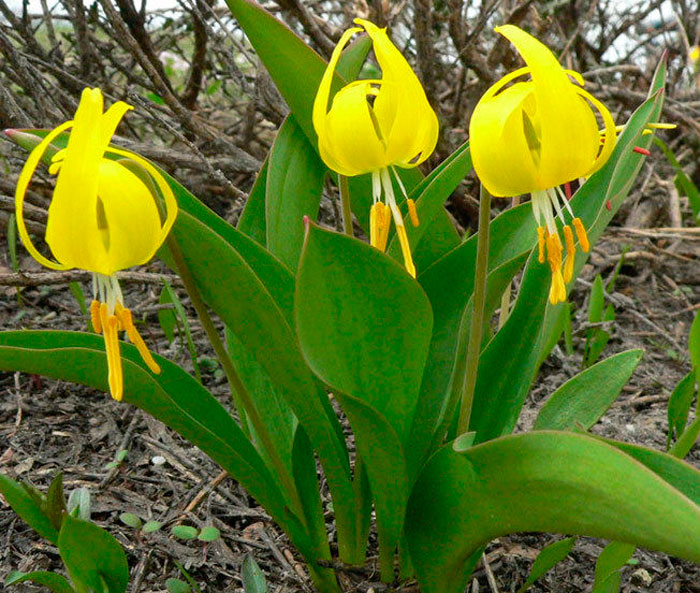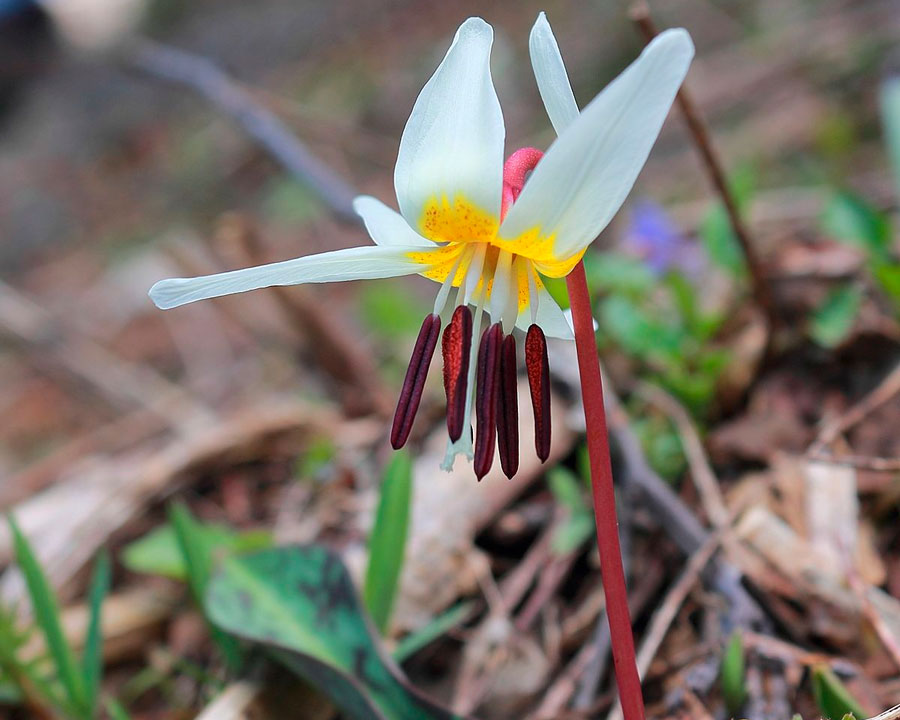Erythronium pagoda (Erythronium) - plant description
Content:
Erythronium pagoda is a flower that pleases with its flowering in early spring. It has an unusual color, which is why many gardeners use it to decorate the garden. Taking care of erythronium will not be difficult. The article will tell you everything you need to know about this plant.
Botanical description
Erythronium is called kandyk in another way. The flower is perennial and belongs to the Liliaceae family.
History of appearance
Kandyk pagoda grows naturally in Europe, North America, Japan, Siberia, and the Caucasus. It grows best in the mountains, in cool, open and light areas. The Siberian species is listed in the Red Book. For Russia, this is a new flower; it amazes many gardeners with its beauty.
Plant features
Kandyk is a flower that begins to bloom in early spring. Its buds resemble lilies. The most common shades of petals are yellow, magenta, white and pink. It grows to a height of 47 cm. It belongs to the bulbous type of plants. Has decorative flowers.
Description of the types of erythronium
The most popular types of Pagoda kandyk are listed below.
American
This variety is native to the subtropics and central parts of the United States and Canada. Flowers grow in the mountains. The bulb is shaped like an egg. The leaves reach a length of 20 cm and a width of 5 cm. There are small brown spots on the leaves. The length of the peduncle is approximately 0.3 m. The petals are bright yellow in color. Sometimes there is a purple tinge.
Whitish
This species blooms in central parts of Canada and the United States of America. Bears resemblance to the American species. The petals can be pink, purple, or blue.
Multi-stem
Grows in the temperate zones of the United States. The places of its distribution are light forests and moist rocks. The leaves are reversed in shape. The flowers are yellow-cream in color with an orange base. The peduncle has one to three flowers.
Henderson
It grows in the state of Oregon in light forests and dry meadows. It appeared in Europe in 1887. The bulb has an oblong shape and short roots. The leaves have dark brown spots. The shoot reaches a length of 10-30 cm. There are one to three flowers on a bush.
Mountain
Grows in the northwestern United States. Prefers alpine meadows. The bulb is oblong. The stem reaches a length of 0.45 m. The leaves are egg-shaped, and strongly narrow towards the base. The flowers are pale pink. The bract is orange.
Lemon yellow
Grows in warm temperate parts of the United States. Found in mountain forests. There are spots on the leaves. Stem height 10-20 cm.
California
Grows in the forests of California. The leaves have a blunt oblong shape. There are spots on their surface. Sheet length up to 10 cm.The stem reaches a length of 0.35 m. Flowers are cream-white. The following varieties are popular among flower growers:
- kandyk Erythronium White Beauty (White beauty). Erythronium White Beauty has snow-white flowers with a dark brown ring in the middle. The perianth leaves are similar to the Chinese pagoda;
- Harvingtone Snowgood. The flowers are creamy with a yellow base.
Large
It grows in the steppes of the USA and Canada. Also found in forests and mountains. The roots are short, with a bulb on them. Stem length from 0.3 to 0.6 m. Leaves are oblong, lanceolate. Their length is 0.2 m. There are from one to six flowers on the stem. The petals are pale yellow. The most popular varieties of this type:
- white - snow-white petals;
- golden - yellow flowers;
- Nuttalya - red anthers;
- Rubens - pink-red petals.
Oregonum
It grows in the subtropics of the Pacific coast of the USA and Canada. The length is from 0.1 to 0.4 m. There are spots on the leaves. They are oblong. Perianth leaves are white-cream in color. A distinctive feature is that it loves moisture. Famous varieties of this species:
- wrapped white-flowered - white petals;
- wrapped Johnson - dark pink color of the buds;
- wrapped white - cream-white flowers.
Tuolumni
Kandyk Tuolumni Pagoda grows only in the Sierra Nevada. Reaches 0.3-0.4 m. The leaves are green, 0.3 m long. The flowers are yellow with a golden tint. The most famous varieties:
- Pagoda - yellow-lemon buds;
- Congo is a hybrid that is created by crossing the inverted and Tuolumni species. The flowers are yellow with a grayish tint.
Siberian
Grows in the southern part of Siberia and Mongolia. The bulb is shaped like an egg. Stem 0.12-0.35 m. Petals of pink-lilac color. Brownish leaves with a green pattern.
Caucasian
Found in the mountain forests of western Transcaucasia. The bulbs are ovoid-cylindrical. Stem length 0.25 m. There are specks on the leaves. The perianth is yellowish or white.
European
Grows in subtropical and warm temperate zones of Europe. The color of the stem is pale pink. Its height is 0.1-0.3 m. The petals are white, pink, purple. There is one flower on the stem. The variety is frost-resistant.
Japanese
It grows in the Kuriles, Sakhalin, Karelia and Japan. Bulbs are cylindrical-lanceolate. Stem 0.3 m. Leaves are oblong. Their length is 12 cm. The bud is purple-pink.
Hybrid
These are varieties that are obtained by combining several species. The most famous among them:
- White knight - snow-white flowers;
- scarlet - flowers of a rich crimson color;
- White canine - pale yellow buds.
Kandyk: landing and care
Growing a kandyk is a simple process. He needs rare watering. Sometimes mulching is required.
Watering
During the growing season, watering should be in moderation. Moisture should not be allowed to stagnate, or the ground should not be excessively dry.
Spraying
The flower does not require additional spraying.
Humidity
For the plant in question, excess moisture is not needed. If the flower is waterlogged, then it can get sick.
Priming
To plant a kandyk, the following soil is needed: leaf turf, garden soil, humus, sand are mixed.
Top dressing
In the first season, fertilizers are not applied. After the flowers fall, organic matter is needed. Mineral fertilizers are applied in the spring.
Features of winter care
Pruning the plant is not worth it. When the flower is at rest, the ground part can be removed. Kandyk is frost-resistant, so it can be left in the open field. However, if there are severe frosts in the region, then it is better to cover the plant with dry foliage and spruce branches.
When and how it blooms
Erythronium bloom begins in early spring. The flower has six leaves.Its color, depending on the species, can be white, cream, pink, blue.
The flower is large, drooping. Duration of flowering is 1 month.
How does it multiply
There are three options for propagating this flower.
Seed planting
The flower in question can be propagated by seeds or children.
Seeds are not pre-processed before planting if they are planted before winter. Those seeds that are planned to be planted in the spring must be stratified. To do this, they need to be kept in a plastic bag with wet sand in the refrigerator for three months.
The soil must be dug up and treated with a drug from ants.
It is better to plant seeds before winter. It is necessary to sow in rows with a distance of 10 cm. The distance between the seeds is 5 cm. It is necessary to deepen by 3 cm. After planting, abundant watering is carried out. There is no need to shelter for the winter.
Seedlings will sprout in the spring. Bulb development is a long process. Flowering will occur in 4-7 years.
Bulb planting
When planting with bulbs, there are certain requirements for each species. Deepening of European-Asian varieties is made by 10-15 cm, and American varieties by 16-20 cm.The interval in both cases is not less than 15 cm.
Reproduction by baby bulbs
With this method, flowering will be next year. Landing takes place at the end of June. Step-by-step instructions on how to do this:
- Prepare the holes.
- Place 3-4 onions in each hole.
- Sprinkle with earth, compact and water.
Possible problems
Erythronium is a disease resistant plant. Pests of the plant bear, moles and mice. Rodent control is carried out using traps. They make holes for the bear, put fresh manure there and cover with something. When a lot of pests gather there, they are destroyed.
Erythronium is a plant that is often used to decorate the site. It is also popular due to the fact that planting and caring for a kandyk outdoors is a simple process. The plant is resistant to diseases and has good winter hardiness.





















